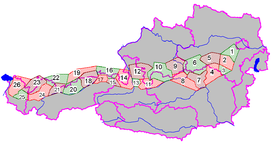| Wetterstein | |
|---|---|
 The Wetterstein and Mieming Chain (left) from the northeast | |
| Highest point | |
| Peak | Zugspitze[1] |
| Elevation | 2,962[1] m (9,718 ft) |
| Coordinates | 47°25′0″N 10°59′42″E / 47.41667°N 10.99500°E |
| Geography | |
 Groups of the Northern Limestone Alps (purple lines showing international borders and the borders of Austrian states) | |
| Countries | Austria and Germany |
| States | Tyrol and Bavaria |
| Range coordinates | 47°25′N 11°8′E / 47.417°N 11.133°E |
| Parent range | Northern Limestone Alps |
| Geology | |
| Rock type | Limestone |










The Wetterstein mountains (German: Wettersteingebirge), colloquially called Wetterstein,[1] is a mountain group in the Northern Limestone Alps within the Eastern Alps, crossing the Austria–Germany border. It is a comparatively compact range located between Garmisch-Partenkirchen, Mittenwald, Seefeld in Tirol and Ehrwald along the border between Germany (Bavaria) and Austria (Tyrol). Zugspitze, the highest peak is at the same time the highest mountain in Germany.[1]
The Wetterstein mountains are an ideal region for mountaineers and climbers. Mountain walkers sometimes need to allow for significant differences in elevation. The proximity of the range to the south German centres of population, the scenic landscape and its good network of cable cars and lifts mean that the mountains are heavily frequented by tourists for most of the year. There are, however, places in the Wetterstein that are rarely or never visited by people.
- ^ a b c d Wettersteingebirge at www.summitpost.org. Retrieved 11 Jun 2017.